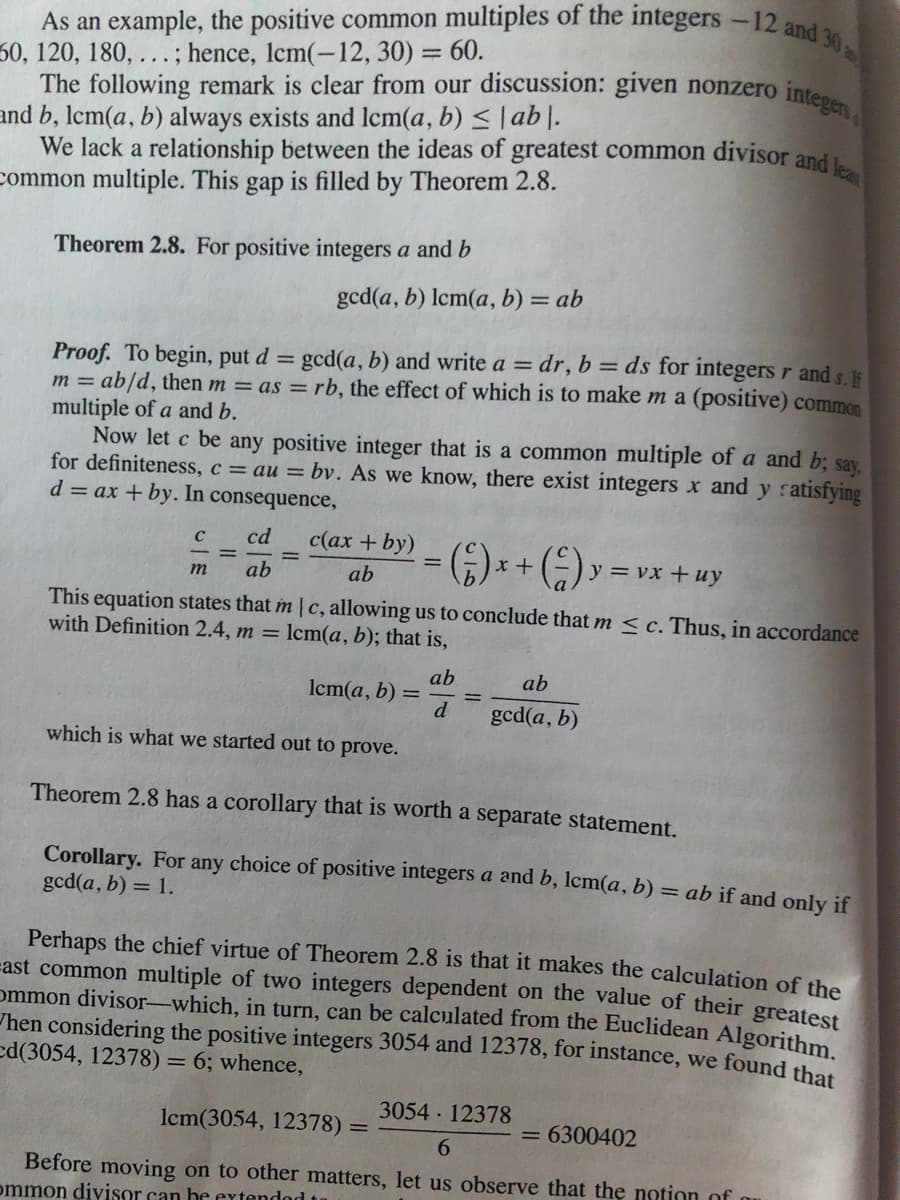For Theorem 2.8 and it corollary give a simplified and short example in order to explain it very well as a presentation. Ps(short and well structured)
For Theorem 2.8 and it corollary give a simplified and short example in order to explain it very well as a presentation. Ps(short and well structured)
Elements Of Modern Algebra
8th Edition
ISBN:9781285463230
Author:Gilbert, Linda, Jimmie
Publisher:Gilbert, Linda, Jimmie
Chapter2: The Integers
Section2.2: Mathematical Induction
Problem 50E: Show that if the statement 1+2+3+...+n=n(n+1)2+2 is assumed to be true for n=k, the same equation...
Related questions
Question
For Theorem 2.8 and it corollary give a simplified and short example in order to explain it very well as a presentation.
Ps(short and well structured)

Transcribed Image Text:As an example, the positive common multiples of the integers -12 and
30, 120, 180, ... ; hence, lcm(-12, 30) = 60.
The following remark is clear from our discussion: given nonzero integers
%3D
and b, lcm(a, b) always exists and Icm(a, b) < |ab|.
We lack a relationship between the ideas of greatest common divisor and
common multiple. This gap is filled by Theorem 2.8.
Theorem 2.8. For positive integers a and b
gcd(a, b) lcm(a, b) = ab
Proof. To begin, put d = gcd(a, b) and write a = dr,b= ds for integers r and s.
m = ab/d, then m = as = rb, the effect of which is to make m a (positive) common
multiple of a and b.
Now let c be any positive integer that is a common multiple of a and b; say,
for definiteness, c = au = bv. As we know, there exist integers x and y ratisfying
d = ax + by. In consequence,
%3D
cd
c(ax + by)
;)* * (E):
y = vx +uy
m
ab
ab
This equation states that m | c, allowing us to conclude that m < c. Thus, in accordance
with Definition 2.4, m = lcm(a, b); that is,
ab
lcm(a, b) =
d
ab
gcd(a, b)
which is what we started out to prove.
Theorem 2.8 has a corollary that is worth a separate statement.
Corollary. For any choice of positive integers a and b, Icm(a, b) = ab if and only if
gcd(a, b) = 1.
Perhaps the chief virtue of Theorem 2.8 is that it makes the calculation of the
=ast common multiple of two integers dependent on the value of their greatest
ommon divisor-which, in turn, can be calculated from the Euclidean Algorithm
hen considering the positive integers 3054 and 12378, for instance, we found thet
ed(3054, 12378) = 6; whence,
3054 12378
lcm(3054, 12378) =
= 6300402
6.
Before moving on to other matters, let us observe that the notion of
ommon divisor can he extendod t
Expert Solution
This question has been solved!
Explore an expertly crafted, step-by-step solution for a thorough understanding of key concepts.
Step by step
Solved in 2 steps with 2 images

Knowledge Booster
Learn more about
Need a deep-dive on the concept behind this application? Look no further. Learn more about this topic, advanced-math and related others by exploring similar questions and additional content below.Recommended textbooks for you

Elements Of Modern Algebra
Algebra
ISBN:
9781285463230
Author:
Gilbert, Linda, Jimmie
Publisher:
Cengage Learning,

Holt Mcdougal Larson Pre-algebra: Student Edition…
Algebra
ISBN:
9780547587776
Author:
HOLT MCDOUGAL
Publisher:
HOLT MCDOUGAL

Algebra: Structure And Method, Book 1
Algebra
ISBN:
9780395977224
Author:
Richard G. Brown, Mary P. Dolciani, Robert H. Sorgenfrey, William L. Cole
Publisher:
McDougal Littell

Elements Of Modern Algebra
Algebra
ISBN:
9781285463230
Author:
Gilbert, Linda, Jimmie
Publisher:
Cengage Learning,

Holt Mcdougal Larson Pre-algebra: Student Edition…
Algebra
ISBN:
9780547587776
Author:
HOLT MCDOUGAL
Publisher:
HOLT MCDOUGAL

Algebra: Structure And Method, Book 1
Algebra
ISBN:
9780395977224
Author:
Richard G. Brown, Mary P. Dolciani, Robert H. Sorgenfrey, William L. Cole
Publisher:
McDougal Littell